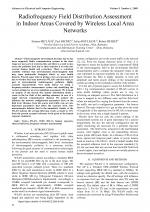| 1/2009 - 9 |
Radiofrequency Field Distribution Assessment in Indoor Areas Covered by Wireless Local Area NetworksMICLAUS, S., BECHET, P., BOULEANU, I., HELBET, R. |
| Extra paper information in |
| Click to see author's profile in |
| Download PDF |
Author keywords
WLAN, IEEE 802.11, human exposure, electric field level, frequency-selective measurement
References keywords
exposure(6), fields(5), electromagnetic(4)
No common words between the references section and the paper title.
About this article
Date of Publication: 2009-02-03
Volume 9, Issue 1, Year 2009, On page(s): 52 - 55
ISSN: 1582-7445, e-ISSN: 1844-7600
Digital Object Identifier: 10.4316/AECE.2009.01009
Web of Science Accession Number: 000264815300009
SCOPUS ID: 67749143618
Abstract
Electromagnetic environment becomes day by day more congested. Radio communication systems in the short range are now part of everyday life, and there is a need to also assess the pollution level due to their emission if we take into account human health and protection. There is consistent scientific evidence that environmental electromagnetic field may cause undesirable biological effects or even health hazards. Present paper aims at giving a view on exposure level due to wireless local area networks (WLAN) emission solely, as part of environmental radiofrequency pollution. Highly accurate measurements were made indoor by using a frequency-selective measurement system and identifying the correct settings for an error-minimum assessment. We focused on analysis of the electric flux density distribution inside a room, in the far field of the emitting antennas, in case of a single network communication channel. We analyze the influence the network configuration parameters have on the field level. Distance from the source and traffic rate are also important parameters that affect the exposure level. Our measurements indicate that in the immediate vicinity of the WLAN stations the average field may reach as much as 13% from the present accepted reference levels given in the human exposure standards. |
| References | | | Cited By «-- Click to see who has cited this paper |
| [1] IEEE 802.11b, Part 11: Wireless LAN Medium Access Control (MAC) and Physical Layer (PHY) Specification: High-Speed Physical Layer Extension in the 2.4 GHz Band, 1999
[2] IEEE 802.11g, Part 11: Wireless LAN Medium Access Control (MAC) and Physical Layer (PHY) specifications, Amendment 4: Further Higher Data Rate Extension in the 2.4 GHz Band, 2003 [3] ICNIRP Guidelines for limiting exposure in time-varying electric, magnetic and electromagnetic fields (up to 300 GHz), Health Phys. 74, 494-522, 1998 [4] European Council Recommendation 1999/519/EC on the Limitation of Exposure of the General Public to Electromagnetic Fields (0 Hz to 300 GHz), 1999 [5] K. D'hoe, G. Ottoy, J. Goemaere, L. De Strycker, "Indoor Room Location Estimation", Advances in Electrical and Computer Engineering, Suceava, Romania, ISSN 1582-7445, No. 2/2008, volume 8 (15), pp. 78-81, 2008 [CrossRef] [Full Text] [Web of Science Times Cited 16] [SCOPUS Times Cited 24] [6] CENELEC EN 50383, Basic Standard for the calculation and measurement of electromagnetic fields related to human exposure from radio base stations and fixed terminal stations for wireless telecommunications systems (11 MHz - 40 GHz), 2002 [7] IEEE Std C95.3-2002. IEEE Recommended Practice for Measurements and Computations of Radio Frequency Electromagnetic Fields With Respect to Human Exposure to Such Fields, 100 kHz - 300 GHz, 2003 [8] Kuhn, S. Kuster N., Development of Procedures for the EMF Exposure Evaluation of Wireless Devices in Home and Office Environments Supplement 1: Close-to-Body and Base Station Wireless Data Communication Devices, Report IT'IS Foundation, 2006 [9] Schmid G., Preiner P., Lager D., Uberbacher R. and Georg R., "Exposure of the general public due to wireless LAN applications in public places", Rad Prot. Dosimetry, 124, 1, pp. 48-52, 2007 [CrossRef] [Web of Science Times Cited 38] [SCOPUS Times Cited 43] Web of Science® Citations for all references: 54 TCR SCOPUS® Citations for all references: 67 TCR Web of Science® Average Citations per reference: 6 ACR SCOPUS® Average Citations per reference: 7 ACR TCR = Total Citations for References / ACR = Average Citations per Reference We introduced in 2010 - for the first time in scientific publishing, the term "References Weight", as a quantitative indication of the quality ... Read more Citations for references updated on 2025-06-01 12:33 in 16 seconds. Note1: Web of Science® is a registered trademark of Clarivate Analytics. Note2: SCOPUS® is a registered trademark of Elsevier B.V. Disclaimer: All queries to the respective databases were made by using the DOI record of every reference (where available). Due to technical problems beyond our control, the information is not always accurate. Please use the CrossRef link to visit the respective publisher site. |
Faculty of Electrical Engineering and Computer Science
Stefan cel Mare University of Suceava, Romania
All rights reserved: Advances in Electrical and Computer Engineering is a registered trademark of the Stefan cel Mare University of Suceava. No part of this publication may be reproduced, stored in a retrieval system, photocopied, recorded or archived, without the written permission from the Editor. When authors submit their papers for publication, they agree that the copyright for their article be transferred to the Faculty of Electrical Engineering and Computer Science, Stefan cel Mare University of Suceava, Romania, if and only if the articles are accepted for publication. The copyright covers the exclusive rights to reproduce and distribute the article, including reprints and translations.
Permission for other use: The copyright owner's consent does not extend to copying for general distribution, for promotion, for creating new works, or for resale. Specific written permission must be obtained from the Editor for such copying. Direct linking to files hosted on this website is strictly prohibited.
Disclaimer: Whilst every effort is made by the publishers and editorial board to see that no inaccurate or misleading data, opinions or statements appear in this journal, they wish to make it clear that all information and opinions formulated in the articles, as well as linguistic accuracy, are the sole responsibility of the author.



